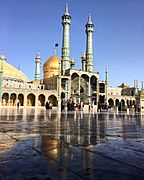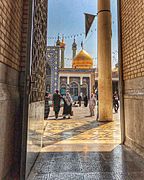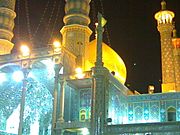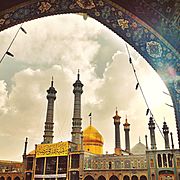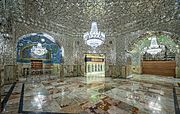Fatima bint Musa facts for kids
Quick facts for kids Fatima bint MusaArabic: فَاطِمَة بِنْت مُوسَىٰ |
|
|---|---|
| Religion | Islam |
| Sect | Shia (Twelver) |
| Personal | |
| Born | c. 790 CE Medina, Abbasid Empire |
| Died | 816 or 817 Qom, Abbasid Empire |
| Resting place | Fatima al-Ma'suma Shrine |
| Parents |
|
| Relatives | Ali al-Rida (brother) |
| Senior posting | |
| Title | al-Ma'suma (lit. the immaculate) |
Fatima bint Musa, born around 790 CE, is a very respected woman in Shia Islam. She is often called Fatima al-Ma'suma (meaning "Fatima, the immaculate"). She was the daughter of Musa al-Kazim, who was the seventh Imam (a spiritual leader) for Twelver Shia Muslims. Her brother, Ali al-Rida, was the eighth Imam. Fatima left her home city of Medina around 816 CE to visit her brother in Merv. Sadly, she became ill on her journey and passed away in Qom, a city in modern-day Iran. She is highly honored for her strong faith and goodness in Twelver Shia Islam. Her beautiful shrine in Qom is a very important place for people to visit on a pilgrimage.
Her Life Story
Fatima was born around 790 CE in Medina. Her father was Musa al-Kazim, the seventh Imam in Twelver Shia Islam. When her father, Musa, died in 799 CE while in prison, many of his followers accepted his son, Ali al-Rida, as the next Imam. Ali al-Rida was Fatima's brother.
In 816 CE, Fatima's brother, al-Rida, was called to a place called Khorasan by the Abbasid ruler, al-Ma'mun. The ruler even named al-Rida as the next in line to lead, possibly to help calm down some of the Shia groups who were unhappy.
Fatima then decided to travel to join her brother in Merv. However, she became very sick during her journey in a town called Saveh. From there, she asked to be taken to the nearby Shia town of Qom. She passed away in Qom a few days later, possibly after seventeen days. Some stories say that a local Shia leader named Musa ibn Khazraj al-Ash'ari brought Fatima to Qom and cared for her in her final days. While there are some reports that Fatima might have been poisoned, these stories are not found in older historical books about Qom. Fatima died in either 816 or 817 CE. Her exact age is not known, but she was at least 21 years old.
Her Special Place in Twelver Shia Islam
Fatima is known by the special title al-Ma'suma, which means "the immaculate" or "the infallible." We don't know exactly when she received this title, but people were already calling her this by the 1400s.
In Twelver Shia Islam, Fatima is seen as a perfect example of "feminine virtues." She is admired for her deep faith, her goodness, and her knowledge of religious teachings. She is often compared to Fatima bint Muhammad, who was the daughter of the Islamic prophet Muhammad. Twelver Shia Muslims believe she is a saint who can help people on the Day of Judgment. They also believe she has performed miracles, like healing people who were very sick.
Her Holy Shrine
Fatima was buried just outside of Qom on land owned by Musa al-Ash'ari. This land later became a public gift. The house where she stayed and prayed became a mosque outside the city.
Her shrine has been expanded and made more beautiful over many years by different rulers and groups. The Buyids and the Seljuks helped develop it, as did the Qara Qoyunlus and the Aq Qoyunlus. The impressive buildings you see today mostly come from the Safavid and Qajar periods in history.
Qom became a very important place for pilgrimages because of Fatima al-Ma'suma's shrine. Visiting her shrine is encouraged by traditions from her brother al-Rida and his son Muhammad al-Jawad, who was the ninth Imam. Because of this, Qom became a major center for Shia learning and activities, especially strong in the 900s.
The shrine was further developed in 1519 by Shah Bigum, the daughter of the Safavid king Ismail I. Later, the Safavid king Abbas I gave money to support the shrine and built a school and a place for pilgrims there. He did this partly to encourage people to visit Shia shrines in his own country, especially before the Ottomans took control of Iraq, where many other Shia Imams are buried.
A religious school, known as Feyziyya, was founded there in 1533. Qom also benefited from being close to Tehran, which was the home of the Qajar kings. The Qajars continued to develop the shrine and buried their dead in the city. The school's academic reputation grew with the help of a scholar named Mirza-ye Qomi. Another period of growth began in 1921 with the arrival of Abdolkarim Haeri Yazdi, who founded the current important religious center. One of his students was Ruhollah Khomeini, who later led the Iranian Revolution in 1979.
See also
 In Spanish: Fátima bint Musa para niños
In Spanish: Fátima bint Musa para niños
- Fatima
- Holiest sites in Shia Islam


